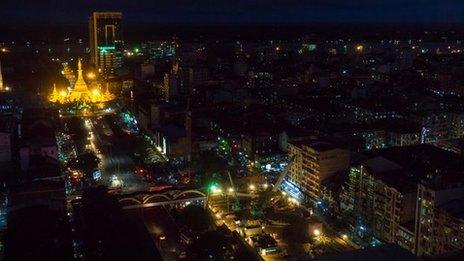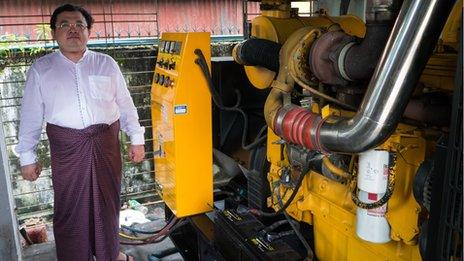Burma's power supply problems hurt growth
- Published
Myanmar wants to entice foreign investors but unreliable energy supplies are a big problem.
The opening up of Burma's economy has generated feverish excitement among international investors.
With a population of 60 million, a wealth of natural resources, and a need for just about everything, Burma, also known as Myanmar, is one of the world's last untapped markets.
And yet, while foreign direct investment has increased substantially since most sanctions were lifted last year, the amounts of real money arriving in the country are far smaller than Burma's needs and nowhere near the impressive numbers being talked about.
There are a number of reasons for this caution, the most common of which is offered by potential manufacturers.
They will be crucial job-creators in this early stage of Burma's development and they say power - or the lack of it - is one of their biggest concerns.
All those decades of isolation have left the country's infrastructure in terrible shape.
There is no national grid and 70% of what power there is, comes from hydroelectric dams. A few months into the dry season, capacity drops sharply, resulting in frequent and long-lasting power cuts.
Per capita power consumption is only one-sixth of that in Indonesia, and one-20th of Thailand's.
.jpg)
In many rural areas, access to electricity is scarce
"Over two-thirds of the country does not have access to electricity," says Kanthan Shankar, the country manager for the World Bank.
"In rural areas it's less than 16%. So there's a huge need."
So the World Bank's first funding project since it returned to Burma last year is, unsurprisingly, to help the government upgrade an old power-station in Thaton, south of Rangoon, also known as Yangon.
Big city problems
Even downtown Rangoon presents an unexpectedly murky cityscape once the Sun goes down.
Only the dazzlingly lit pagodas shine out, along with the small number of modern high-rises that have been built. Once you get outside the city, it gets a whole lot darker.

The further away from the city you go, the darker it gets
In one school, just 10km (six miles) from Rangoon, I saw a couple of fluorescent light bulbs. But I was told they only worked if attached to a car battery.
For hospitals and clinics, which are already chronically underfunded, the lack of power means medicines cannot be kept cool.
In the villages around Rangoon, you can see a tangle of old wires sending a dribble of current to a few of the houses. There is never enough, though, even when the power is on.
.jpg)
Some businesses have been cashing in on the lack of adequate power supply by making generators
While offering me shelter from a monsoon thunderstorm, Kyaw Win, an Irrawaddy river pilot, showed me the voltage regulator he has had to buy to boost the electricity supply to usable levels.
Needless to say the power was off at the time.
Business opportunities
The one industry that does very well out of this is, of course, is generator-makers.
In the days of sanctions, imports were either blocked or unaffordable, so enterprising engineers learned to refurbish old truck engines into generators. Now the demand for electricity outstrips supply, they say they are working flat out.
But generators are no substitute for a reliable electricity supply.
Out at the Hlaingtharyar industrial zone, west of Rangoon, garment manufacturing has expanded rapidly since sanctions were lifted. With some of the lowest wages in Asia, this is one area where investment is coming quickly, and creating jobs.
Power remains their biggest headache.
Khin Maung Aye employs 1,500 workers in his factory.

Local manufacturers, such as Khin Maung Aye, have to rely on generators
But for four months of the year, he loses money because of the enormous cost of running generators.
The diesel they use has to be imported, because although Burma has oil, it does not have much refining capacity. On hot days, when the power is out for 24 hours, the fuel costs him $1,500 (£940).
The biggest proposed investments are coming from Japanese companies, eager to make up for the lost years of sanctions when they had to watch arch-rival China become Burma's top trade and investment partner.
Carmakers Nissan and Suzuki have announced plans for local assembly lines.
Thousands of Japanese business executives visit every month. But only a few stay.
"The Burmese call us Nato," says Masaki Takahara, head of the Rangoon office of Japan External Trade Organization (Jetro).
.jpg)
Garment manufacturing has expanded but running generators in factories can be costly
"No Action, Talk Only. Or the 'four Ls' - Look, Listen, Learn and Leave."
Of the 120 members of the local Japanese Chamber of Commerce, only seven are engaged in manufacturing. The main problem, he says, is the lack of suitable infrastructure, and in particular, reliable power.
The Japanese solution to this is a plan to build a massive industrial estate next to the port of Thilawa, south of Rangoon. Jetro hopes to sign the final memorandum of understanding with the Burmese government later this month and start construction by the end of the year.
At its heart will be a new 500MW power station. But, says Mr Takahara, the government still cannot guarantee a supply of gas to fuel the plant.
Renegotiating contracts
Burma has huge reserves of natural gas.
But under military rule, when power consumption was very low, the government sold most of that gas on long-term contracts to Thailand and China.
Now it's trying to renegotiate those contracts so it can meet the needs of its own people and businesses.
With multinational companies bidding to expand exploitation of Burma's gas fields, output should increase rapidly over the next decade.
That's what the Japanese are counting on.
Otherwise, the grand plans for a new, low-cost manufacturing outpost in South East Asia will struggle to get off the ground.
- Published28 May 2013
- Published10 September 2013